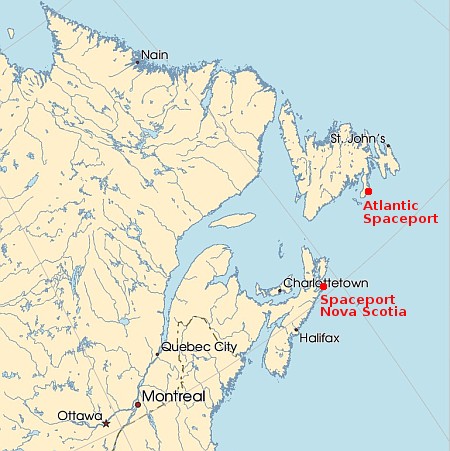Maritime Launch Services touts a second non-orbital launch from Spaceport Nova Scotia

Proposed Canadian spaceports
The competition between Canada’s two proposed spaceports heated up yesterday when the owner of Spaceport Nova Scotia, Maritime Launch Services, announced that the second launch had taken place there, this time by a rocket startup named T-Minus Engineering.
The launch took place at 11:54 AM, and the mission marked an important milestone in advancing the operational readiness of Spaceport Nova Scotia, critical infrastructure that will provide Canada with sovereign launch capability. The launch was conducted from Spaceport Nova Scotia under approved regulatory and safety frameworks. The demonstration strengthened coordination among launch site teams and stakeholder partners, while refining launch operational procedures and the safety and security systems that govern all activities at the spaceport.
The press release provided no details about the launch itself, though this report noted that the rocket failed to reach its goal of 100 kilometers, the altitude considered by most as the edge of space. The rocket, dubbed Barracuda, is solid-fueled and was apparently designed by T-Minus to demonstrate its capability for hypersonic testing.
This was the second suborbital launch from this spaceport. The first, in 2023, was a student test flight. In both cases, the launches were mostly a PR effort to sell the spaceport, which was first proposed in 2016 but has been unable so far to draw any launch customers. Maritime now also faces competition from the Atlantic Spaceport being proposed by a different company, Nordspace.

Proposed Canadian spaceports
The competition between Canada’s two proposed spaceports heated up yesterday when the owner of Spaceport Nova Scotia, Maritime Launch Services, announced that the second launch had taken place there, this time by a rocket startup named T-Minus Engineering.
The launch took place at 11:54 AM, and the mission marked an important milestone in advancing the operational readiness of Spaceport Nova Scotia, critical infrastructure that will provide Canada with sovereign launch capability. The launch was conducted from Spaceport Nova Scotia under approved regulatory and safety frameworks. The demonstration strengthened coordination among launch site teams and stakeholder partners, while refining launch operational procedures and the safety and security systems that govern all activities at the spaceport.
The press release provided no details about the launch itself, though this report noted that the rocket failed to reach its goal of 100 kilometers, the altitude considered by most as the edge of space. The rocket, dubbed Barracuda, is solid-fueled and was apparently designed by T-Minus to demonstrate its capability for hypersonic testing.
This was the second suborbital launch from this spaceport. The first, in 2023, was a student test flight. In both cases, the launches were mostly a PR effort to sell the spaceport, which was first proposed in 2016 but has been unable so far to draw any launch customers. Maritime now also faces competition from the Atlantic Spaceport being proposed by a different company, Nordspace.
